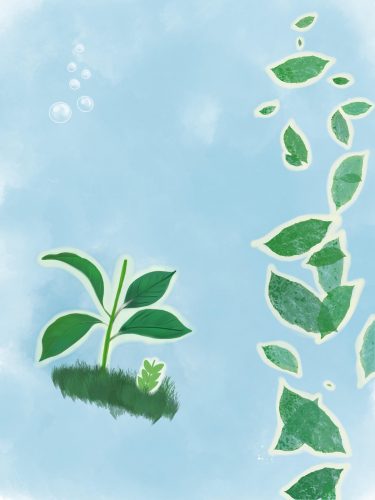Art by AnMei Little.
Hydrophobic materials have many applications, yet many are easily disrupted by the environment, losing their dryness. To find the key to the next generation of highly water-repellent materials, scientists have turned to Mother Nature for inspiration, studying species that thrive in water, like lotus plants and ferns.
Recently, Xiang Yaolei and his team at Peking University investigated the hydrophobic leaves of Salvinia molesta, a sturdy fern species best known for being highly invasive. The researchers discovered that the Salvinia leaf had evolved surface patterns ideal for generating a smooth layer of air underwater. They then replicated this design on a 3D printed specimen. This work paves the way for improved underwater applications, such as reduced drag on underwater vehicle and improved protection against corrosion in pipes.
In a laboratory study of carefully degassed underwater Salvinia leaves, the researchers observed that an air layer forms spontaneously on the leaf surface. For accuracy purposes, the researchers applied a high water pressure to remove any trapped air on underwater Salvinia leaves first, then injected new air via a small syringe. “It is different from a lotus leaf. Here, a whole layer of air forms, while for the lotus only a few individual bubbles appear. The Salvinia mechanism is an active replenishment of air,” Xiang said.
Scientists and engineers sought to discover the underlying design behind the Salvinia leaf’s active replenishment mechanism. Using a scanning electron microscope, the team found three key features of the Salvinia leaf’s hydrophobicity: interconnected wedge-shaped microgrooves on the leaf’s surface, long hair stems, and eggbeater shaped heads. The wedge-shaped microgrooves enabled stable air pockets to form and expand by capillary action, going against the flow of gravity. The interconnected and widespread microgrooves allow air to spread efficiently and spontaneously across the leaf surface.
The researchers found that, once formed, the air layer then rises along the frame provided by the hairy stems. Moreover, the eggbeater-shaped head, which caps the microgrooves and hair stems, stabilizes the entire air layer by surface tension. As the stems of the plant are irregular, the air layer arrived at the top of short stems will pin and “wait” for the air layer arrived to the top of high stems. These three features combine to actively replenish the air layer, even in the presence of water flow. Hence, compared to passive hydrophobic materials, the Salvinia design is more reliable in sustaining an air layer.
Xiang is enthusiastic about the industrial applications of Salvinia-inspired hydrophobic materials. “As it is an efficient way to protect the air mattress in different environmental conditions, it will expand the applications of super-hydrophobic surfaces, especially in extreme environments,” Xiang said.
An application of particular interest is the anti-corrosive coating on ship keels. Corrosion below the waterline weakens and damages the ship. A passive solution is anti-corrosion chemical paint, though it degrades over time and leaves environmental residues. Current active systems inject bubbles to stick to the surface, but this must be done continuously and while fully submerged. Xiang believes an industrial translation of the Salvinia system—microgrooves, long stems and eggbeater-shaped heads—could create a self-replenishing active system that prevents prolonged wetting along the ship hull. A similar approach might protect pipelines as well, reducing maintenance costs and improving water quality.
Another potential application is drag reduction to enable faster underwater vehicles. An object moving in a fluid experiences a resistance to its motion, which can be reduced significantly if the object is enveloped in an air cocoon. Compared to current methods of generating this air cocoon, Xiang’s research may have wider usage. “Methods like supercavitation work only at high speeds,” Xiang said. The Salvinia-based design could achieve drag reduction “even at lower Reynolds numbers,” where the object moves slowly in a less turbulent manner. In the lab, the air layer is retained at low fluid velocity of half a meter per second. Further research would be needed to scale up this speed for use in ships, where the water flows at a few meters per second.
To replicate Salvinia’s natural patterns on artificial surfaces, the Peking University researchers 3D printed a specimen with regular microgrooves, long stems, and eggbeater bulbs. Due to the extreme precision required, the overall sample size was a square of four millimeters in length. The team printed a Salvinia-inspired design (complete with microgrooves, stems and eggbeater heads) as well as a control specimen (with stems and eggbeater heads only). Using a confocal microscope, Xiang and the researchers found that a smooth layer of air only appeared in the first sample. In the control, individual air bubbles formed instead. Hence the Salvinia’s microgrooves are an essential component to achieving a smooth air layer, even more so than the hydrophobic lotus leaf, which only has long stems and eggbeater bulbs. The lotus, as represented by the control, cannot recover its air layer once disrupted.
In a further investigation using the 3D printing apparatus, the researchers varied the microgroove angles to test the predictions of their air layer formation theory. Using a thermodynamic free energy model, the researchers calculated the angle requirement for a stable air layer to form spontaneously. The natural Salvinia leaf’s microgroove angle matched that range, and additional 3D printed tests verified the range of full, partial, or no expansion. Again, experiments showed that the microgroove pattern is critical for the Salvinia plant’s strong hydrophobic capability.
Following his lab’s focus on boundary layer stability research, Xiang and his team’s research on the Salvinia leaf gives new understanding of the boundary layers of a submerged body. “We wanted to find out what made the air layer on Salvinia plant so stable. It turns out the hydrophobicity gives an extremely strong adaptability to environmental conditions. This also provides a theoretical basis for the design of artificial bionic materials,” Xiang said.
The Salvinia leaf, which actively replenishes its air layer through a discreet anatomy, is one of the most effective water-repellent surfaces we know of currently. A humble leaf holds many secrets.

